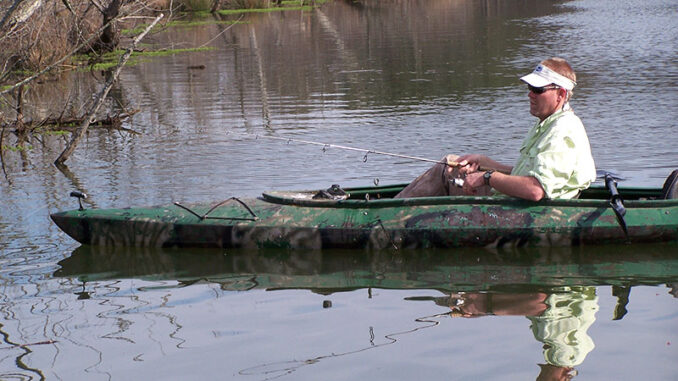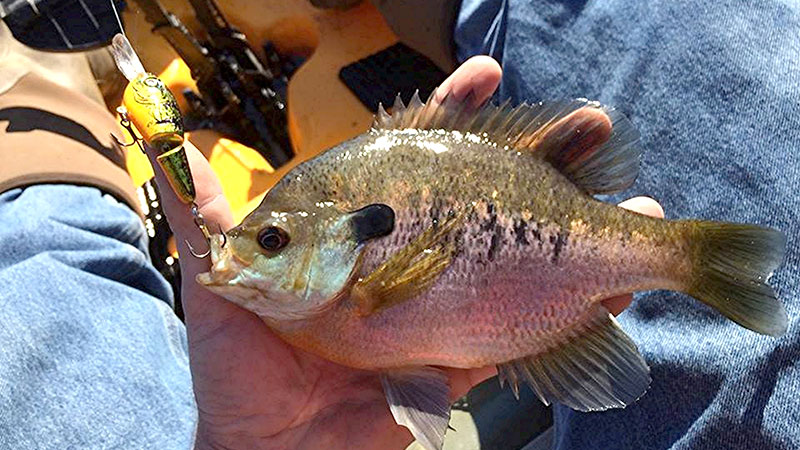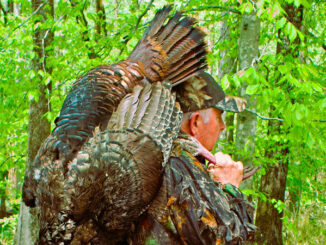
With an abundant panfish population ranging from crappie to bream and even a few panfish species that we tend to forget about, if you are looking to take home a few fish for the table, April is prime time.
As a kayaking angler, you’re in a great position to take advantage of panfish spawns, since most panfish seek out shallow, hard-to reach areas to procreate. And those type places are the specialty of kayak anglers.
Here’s a breakdown of some popular and maybe less-than-popular panfish species that kayak anglers can take advantage of this month.
Crappie – The Carolinas are home to both black and white crappie. Black crappie tend to spawn a few weeks earlier than white crappie. Look for these fish to go on the beds starting mid-March, and then look for whites to head in around mid-April. The farther east you go, you can shave a week or two off these date ranges.
Leave the blind casting of random bank lines to boating anglers. Throw your kayak into the most backwater area you can find that has 3 – 4 feet of water and take an 8 – 9 foot jig pole and a handful of hair jigs and go jig standing timber. Let out enough line to reach the bottom, but don’t bounce the bottom. Hold the jig vertical in the water as close to the base of a tree or bush as you can find. If spawning crappie are in the area, they’ll let you know.
Redear Sunfish – Most everyone refers to these fish as shellcrackers. Shellcrackers are not particularly boat shy. Still, rather than paddling and fishing, try to locate that first one on an underwater saddle between an island and the shoreline, or in the back of a dead bay or on a sandbar that extends into deeper water. Then anchor down to fish the bed. If you did any winter scouting when the water was down, those creeks or cuts where the exposed shoreline was lined with mussel shells is going to be a money spot now that the water is back up.
Shellcrackers feed on the bottom, but will hit artificial baits such as jigs and small Beetle Spins in dark or earthy colors. These are great search baits. If you think you’ve honed in on a bed, stay back, anchor or stake down, and cast whole redworms of half nightcrawlers on a split shot rig with ultra-light tackle to the target area.

Bluegill – Most people lump bluegill, shellcrackers and redbreasts into the bream category, but ‘gills won’t spawn until late in the month and likely into May. The moon plays a big part in when all panfish spawn, but if you wait until the full moon in May, you’ll miss a good bit of the best fishing.
Bluegills will feed on the bottom, but first choice is surface feeding on aquatic insects. A cricket cage and a bream buster with a small cork always has been and always will be a deadly tool for catching bluegills. Look for areas of hard sandy bottom. If you can find the right combination of natural or man-made cover and shallow water with hard bottom, you can catch bluegills.
One of the most fun and productive ways to catch bluegills is with a 3 weight flyrod, floating line and small popping bugs. Additionally, it’s the easiest fly fishing there is with a whole lake behind you for back casting.
On the other hand, if you have access to a private farm pond, go there. Farm ponds produce slab bluegills, and you don’t have to worry that someone got to your bream bed yesterday and cleaned it out.
White Bass – The average size of a white bass in the Carolinas makes it a stretch to include as a panfish, but they are schooling fish and will readily bite during their spawning runs, although they can be somewhat elusive the remainder of the year.
Not all lakes have enough white bass in them to make the fish a viable target. But for those lakes that do have them, take a buddy and drop a vehicle downstream on one of the main tributary arms of the lake. Go far enough up the arm that you’re fishing moving water.
With a light action rod, and 6-pound test monofilament line, let the kayak drift with the current and fan cast an inline spinnerbait perpendicular to the shoreline or current, making sure to take advantage of any current breaks that could hold fish. A paddle yak with a foot-controlled rudder makes this kind of fishing easier.
If you run out of current further down the lake, the fishing tends to slow down appreciably.
White Perch – The white perch used to be the bane of existence to everyone except catfish and striped bass anglers who used them for bait. White perch initially migrated up coastal rivers to spawn, then returned to the ocean. But like their cousins, striped bass, they can live their entire life cycle in freshwater, with the added bonus of reproducing successfully. So their numbers have sky-rocketed.
Similar to white bass, white perch will migrate up moving rivers to spawn in late February to early March. The downside is these fish feed almost exclusively on other fish eggs and fry during their spawning cycles. This makes them a menace to other species.
As larger specimens make excellent table fare and have no creel limit in either state, catching and keeping a mess of white perch benefits everyone. Perch love points and, in one of life’s greatest mysteries, 14 feet of water. You can anchor or simply float over a point in that depth range and vertically jig a small jigging spoon. Perch love bright colors, so plan accordingly. Smaller fish will eat worms fished vertically on a split shot rig, while larger ones seem to prefer large shiners in the 2-inch size range.
Warmouth Sunfish – Probably the most misunderstood and misidentified panfish around, warmouths, also called rock bass, mollies, and goggle-eyes are found in slow moving black water sloughs and swamps. While usually considered a coastal plain fish, a few piedmont lakes also have thriving warmouth populations.





Be the first to comment